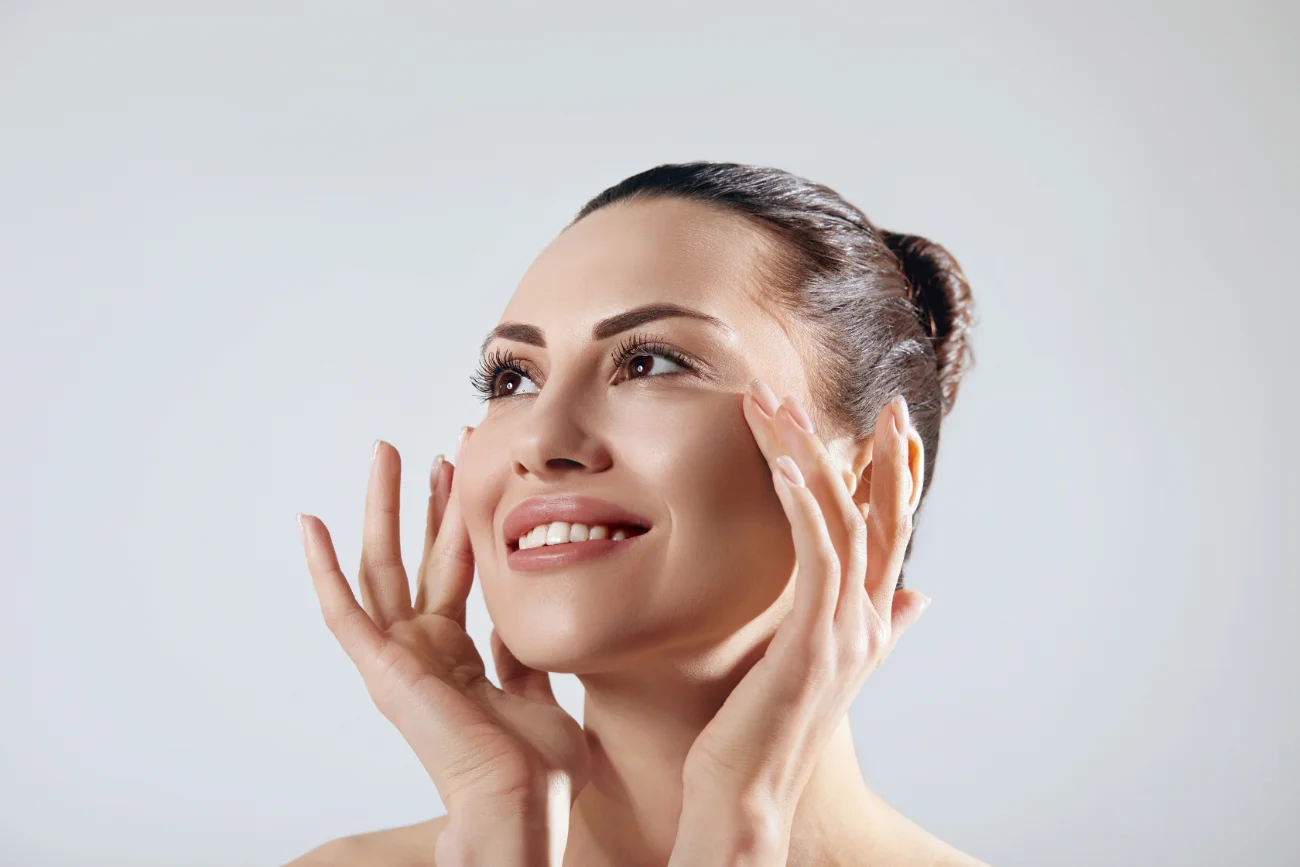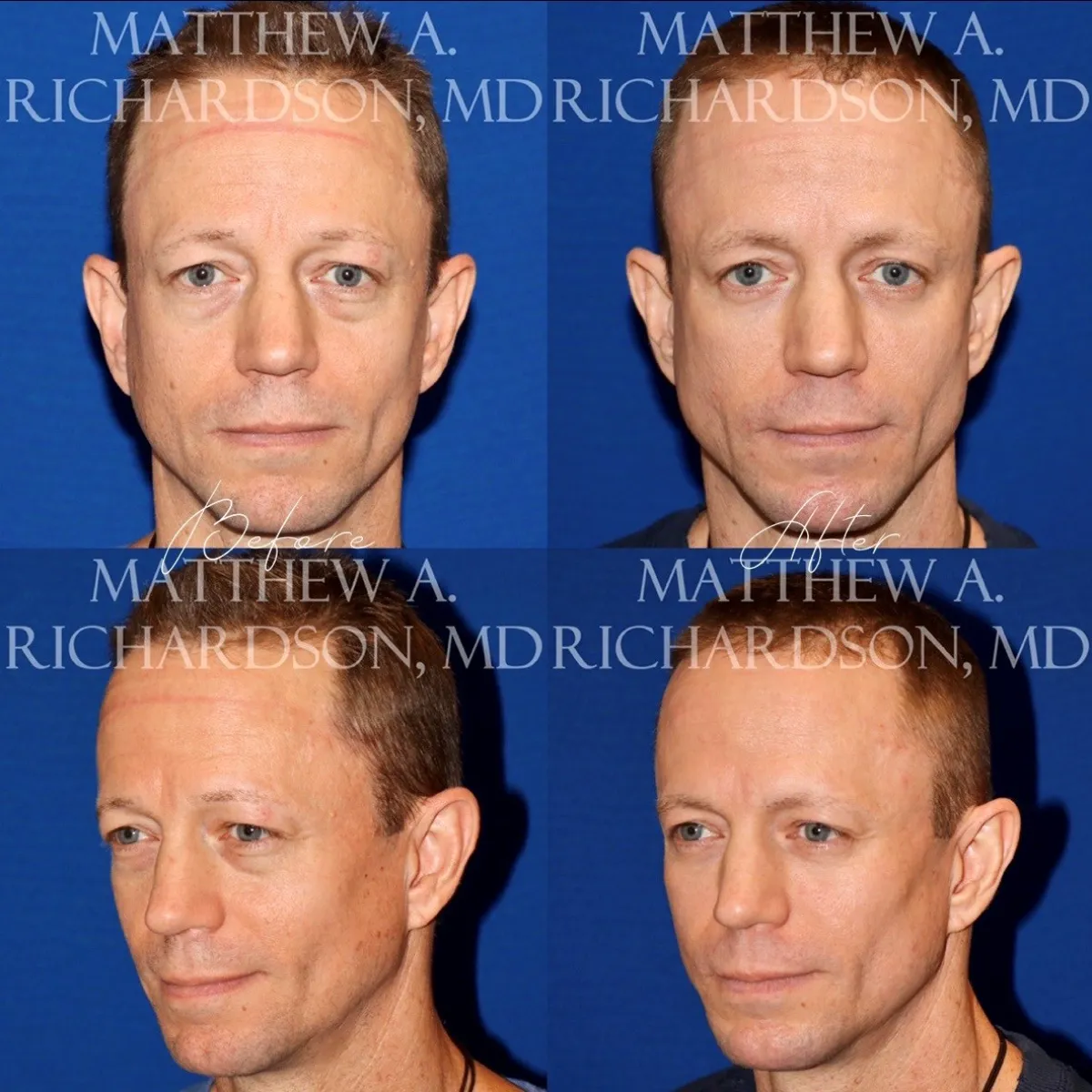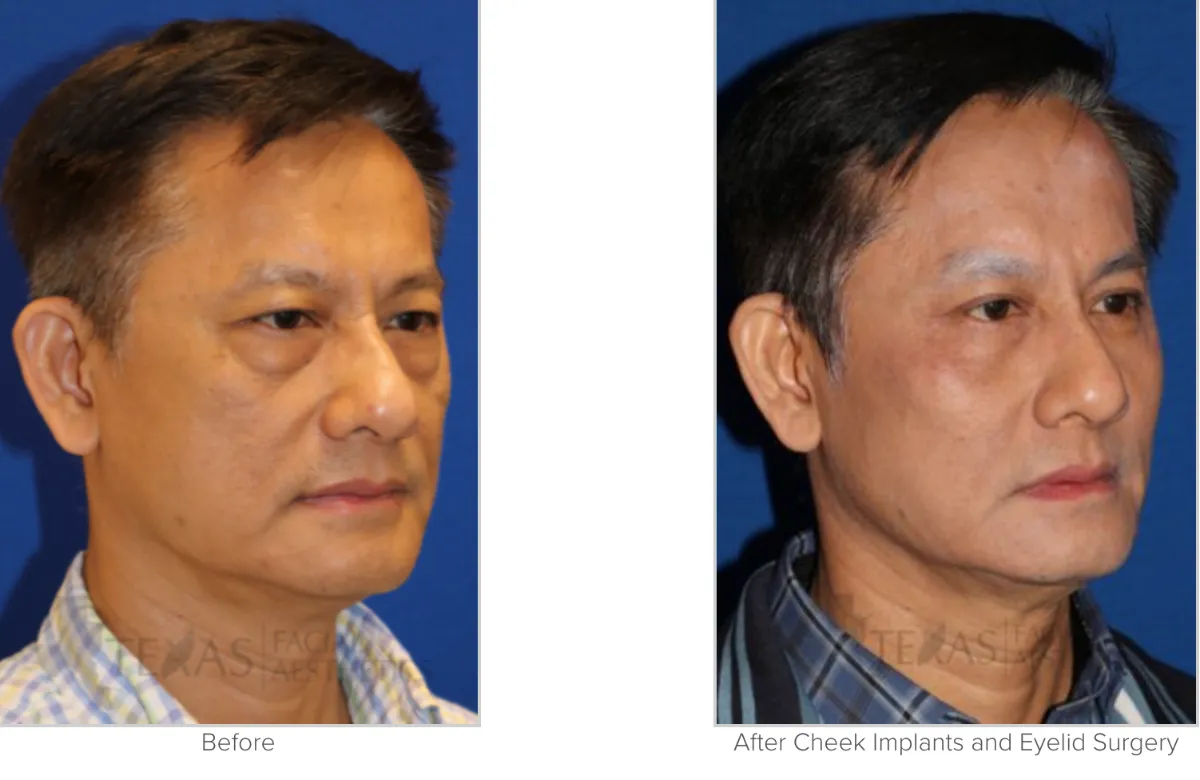Cheek Augmentation
Conveniently Located to Serve the Dallas, Fort Worth, Collin, and Denton Counties.



What is a Cheek Augmentation?
One approach to volume loss in the cheeks involves cheek augmentation with cheek implants. A cheek implant is made of a synthetic material (usually a plastic, silicone, or rubber) that is inserted into the facial soft tissues near or on top of the bone to add volume to the cheeks. As an alternative, we commonly perform cheek augmentation using injectable facial fillers or facial fat grafting. CLICK HERE to learn more about injectable fillers or CLICK HERE to learn more about facial fat grafting (also known as fat transfer or fat injection). There are many different fillers that can be used in the cheeks, and can be placed quickly and easily in just a few minutes during an office visit. Fat grafting is another excellent option which will be compared and contrasted with cheek implants and fillers below.

Is cheek augmentation painful?
Cheek implants and facial fat grafting are performed under IV sedation for comfort during the procedure. Postoperatively, there is very little pain. Most patients report some mild soreness at the incision site within the mouth or some soreness of the cheeks themselves, but these symptoms are short-lived and mild. Patients who undergo cheek augmentation with injectable fillers experience very minor discomfort during the injection process in the clinic, and report occasional mild soreness of the cheeks for a day or two post-injection. Patients who undergo facial fat transfer for cheek volume augmentation will experience similar symptoms. Fat grafting patients will feel some mild soreness of the cheeks for a few days after the procedure.
As we age, the soft tissues of the cheeks tend to relax, separate, and descend to the lower parts of the face, resulting in a deflated, tired, or aging appearance. Facial volume tends to shift “down and in” toward the mouth and lower face over time, and we work to move volume “up and out” as it normally appears in youthful faces. This is extremely common, and often overlooked when patients assess themselves and their areas of concern. These changes happen slowly over time and may only be noticeable when looking at photos of themselves from years or decades earlier. In many cases, sagging jowls, deepening smile lines, or facial wrinkles are caused partially by volume loss within the cheeks, and procedures such as facelifting or skin resurfacing procedures might also need facial volume improvement with cheek augmentation in one of the ways described here. Fortunately, there are several ways to address these issues quickly and easily.
How is cheek augmentation performed? What happens during cheek augmentation?
Cheek implants can be inserted through various techniques, but we typically use an incision made through the mouth under the lip, which leaves no scar on the skin. In our technique, the soft tissue is elevated away from the bone, and a very precise pocket is created for the implant. We typically use a type of implant called a submalar implant that is made of silastic (a firm rubbery type of material) that sits tightly against the hollow of the mid-face and cheek area. The submalar implant is sized intra-operatively by the surgeon and held in place by the tight pocket without the need for screws or other fixation devices. The implant conforms to the shape of the bone to help hold it in place. The pocket is then closed securely along with the small incision under the lip on each side, with dissolvable sutures that stay in place for about 10 days. This procedure results in immediate cheek volume and contour improvement and typically can be performed in less than 30 minutes. While cheek implants can be placed as a stand-alone procedure, we also often place them at the same time as a facelift, eyelid surgery, or other facial procedures.
What can I expect after cheek augmentation? What is the recovery like after cheek implants?
Cheek augmentation patients will experience slightly different post-procedure symptoms depending on the method used for cheek augmentation. Cheek implant and fat grafting patients will have some mild soreness for a few days after the procedure as described above. The cheeks will feel a bit stiff and swollen as well. Some patients may also feel some temporary numbness of the cheeks. Bruising is possible but usually not severe. Patients should avoid physical activity like lifting, straining, or exercise for two weeks after fat grafting or cheek implants. Most cheek implant and fat grafting patients are back to work or school within one week after surgery, with the understanding that all facial swelling will not be fully resolved at that point. Facial filler patients may experience many of the same symptoms described above, but to a lesser extent, and can return to work, school, and social activities the same day. Injectable patients are instructed to avoid any physical activity until the next day.
What are the contraindications to cheek augmentation?
Contraindications to cheek augmentation would include any active infections, bleeding disorders, wound healing disorders, or other medical conditions that would prevent patients from having anesthesia or other cosmetic facial procedures. Patients with poor dentition or ongoing dental disease might not be candidates for cheek implants because of the small incisions made within the mouth that might not heal well or might be at risk of infection in these patients.
Is cheek augmentation safe for all skin types and ethnicities?
Yes! Cheek augmentation is safe for patients that meet the criteria listed above regardless of skin color, ethnicity, race, etc.
How are cheek implants different from cheek fillers or facial fat grafting?
Cheek implants are a synthetic material inserted onto the surface of the bone surgically. These implants provide permanent volume improvements to the cheeks and will remain unchanged over time. Cheek implants are a great option for patients with moderate to severe volume loss who desire the most cost-effective long-term solution to facial volume loss. One downside to cheek implants is that are designed only for the central cheeks and extended tear trough areas, and will not address other areas like the temples or lower smile lines (marionette lines) at the same time.
Facial fat grafting is another extremely popular option. Fat grafting is longer lasting (usually on the order of 3-5 years) than filler injections, but not as long-lasting as permanent cheek implants. Fat grafting involves taking fat from somewhere else on the body (usually the thighs), processing/refining that fat, and reinjecting that fat into the desired areas, often the cheeks. An advantage of fat grafting over cheek implants is that fat grafting does not require any synthetic or foreign materials as both cheek implants and filler injections do. This avoids the risk of the body rejecting or causing inflammation around foreign material. Fat can also be transferred strategically to different facial areas for full facial volume restoration. We commonly perform fat transfer to the temples, cheeks, tear troughs, lower eyelid areas, smile lines, and other areas as needed or desired. The downside is that fat grafting is more invasive than facial filler injections, and less long-lasting than cheek implants. That being said, facial fat transfer is a great option for patients undergoing other surgical procedures who would like to avoid a permanent implant and understand that the volume changes will fade over time. CLICK HERE to read more about fat grafting.
Injectable fillers are obviously extremely popular. Many different filler injections exist, and we carry all the major filler products. We most commonly use hyaluronic acid fillers such as those in the Juvederm and Restylane families. The advantage of fillers are that they are quick and easy to perform in the office with minimal to no downtime. The disadvantage is that they are relatively less cost-effective than cheek implants or fat grafting, and the results do not tend to last as long either. CLICK HERE to read more about injectable fillers like Voluma for the cheeks. Dr. Richardson and Dr. Cain are happy to discuss the advantages and disadvantages of cheek implants versus cheek fillers or fat grafting for cheek augmentation during your consultation.
When should you get cheek augmentation? Who is the best candidate for cheek implants?
Cheek augmentation can be performed in adults of almost any age, depending on the patient’s anatomy. Injectable cheek fillers might be indicated for young patients even in their early 20’s, and fillers are commonly used for patients of all ages. Fat grafting can also be used in patients of all ages depending on their treatment goals and anatomy. Cheek implants and fat grafting are most commonly combined with facial rejuvenation procedures like facelifting, eyelid surgery, etc. but may also be combined with other facial contouring or cosmetic procedures like neck liposuction, buccal fat reduction, lip lift, rhinoplasty, etc.
Is cheek augmentation only for women?
No! Men and women both commonly need volume augmentation in the cheeks. In fact, MANY men need restoration of facial and cheek volume, and we commonly perform all of these procedures in both men and women.
Who is qualified to perform cheek augmentation?
Cheek augmentation should be performed by board-certified physicians who specialize in facial aesthetic procedures. Many cosmetic dermatologists are excellent injectors of fillers, but generally should not be performing cheek implants or facial fat grafting. These surgical cosmetic procedures should be performed by a facial plastic surgeon or general plastic surgeon who specializes in facial procedures. Dr. Cain and Dr. Richardson are facial plastic surgeons who specialize in only facial cosmetic procedures and are well-versed in ALL of these techniques so that they can discuss and offer you the best option for you as an individual.

Are cheek implants safe? Is cheek fat grafting safe? What are the risks of cheek fillers?
In general, all of these three procedures (cheek implants, facial fat transfer, and injectable fillers) are very safe procedures, but all procedures have some risk involved. The risks are similar between the three procedures, including risks of infection, pain, bruising, swelling, scarring, bleeding, asymmetry, need for revision surgery, implant extrusion, undesirable cosmetic outcome, nerve injury, an inflammatory reaction to the product, or anesthesia complications. While mild soreness, bruising, and swelling, are to be expected, most of these other risks listed above are extremely rare events.
How much does cheek augmentation cost? Are cheek implants expensive?
Cheek augmentation costs can vary widely from one procedure to the next depending on what is being performed. With respect to cheek augmentation with filler injections, fillers are priced per syringe, and will generally cost between $700 and $900 per syringe. Most patients will require at least 2-3 syringes to see significant changes. Keep in mind that these fillers will usually need to be repeated every year or two to maintain the results, and the results will generally be less dramatic than fat grafting or cheek implants.
Facial fat grafting will generally cost between $3500 and $5000 per session, but patients can expect longer-lasting results than fillers and much more significant volume changes if desired.
Finally, cheek implants provide permanent volume changes in one quick procedure and costs are comparable to facial fat grafting, usually in the $4500 – $6000 price range. These costs will vary depending on if other procedures are being performed simultaneously, as this will affect anesthesia costs, facility fees, etc. We are happy to provide each patient a customized quote during their consultation.
What is a cheek implant?
A cheek implant is a synthetic implant designed to restore or add facial volume to the central cheek. There are MANY different types of cheek implants that are available. Synthetic implants are commonly used throughout the human body for various medical and cosmetic purposes such as artificial joints, prosthetic heart valves, breast implants, chin implants, etc. Most commonly-used cheek implants are made of a plastic or rubbery materials including porous polyethylene, expanded polytetrafluoroethylene (ePTFE), or silicone (silastic). We use silastic implants that are very safe, reliable, and have low complication rates with long track-records of safety over decades of use.
Will I look different after cheek implants?
Yes, patients will see restored or enhanced cheek volume with any of these techniques discussed here. We want every patient to look natural – just a refreshed or younger version of themselves.
How long does cheek augmentation last? Is cheek augmentation permanent?
Cheek implants are permanent and do not change over time. The results are immediate. Fat grafting is a long-lasting approach, but not considered totally permanent (more on the order of 3-5 years). Injectable fillers typically last 12-18 months in most patients, but occasionally will last longer depending on the patient’s metabolism and the amount of product that is used. Keep in mind that the aging process continues, so patients will continue to see evolving volume loss and volume position changes over time.

*Individual Results may vary.
Real Patient Photo Gallery
View before-and-after pictures of real patients
How can I set up a Cheek Augmentation Consultation?
Call or text Texas Facial Aesthetics at 469-362-6975 to set up a consultation with either Dr. Matthew Richardson or Dr. Jordan Cain. You can also email us at info@txfaces.com for more information.
